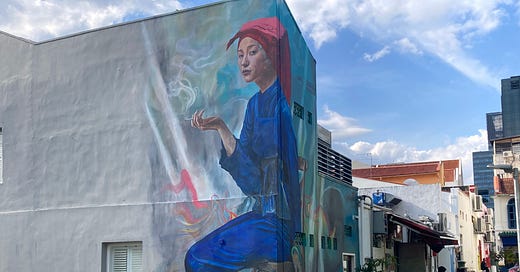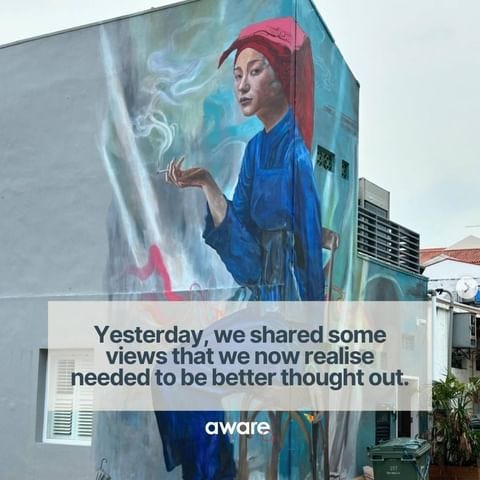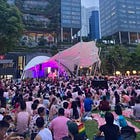The mural of the story: debates over cigarette depiction in Singapore's Chinatown
In sanitizing its image, has the city-state inadvertently (over)sanitized its approach to art, as well as its own history?
This could have been just another artwork embellishing Singapore’s touristy Chinatown area, but ended up sparking much online debate.
Shortly after Singapore-based multidisciplinary artist Sean Dunston unveiled his mural, depicting a samsui woman on a cigarette break, on the back end of a shophouse at 297 South Bridge Road, a member of the public filed a complaint with the Urban Redevelopment Authority, the government agency that regulates shophouse murals in Singapore’s historical areas. The complaint stated that the mural was offensive as it depicted a woman who “looks more like a prostitute than a harworking samsui woman.”
It didn’t take more for URA to issue both Dunston and the owner of 297 South Bridge Road with a notice demanding the cigarette be erased or replaced by July 3. The artist then took over to Instagram to denounce the agency’s assessment. His post quickly garnered attention, and sparked a debate over URA’s decision to have the mural altered.
Samsui women (红头巾, ‘red headscarf’) were a group of female migrants from southern China who came to British Malaya and Singapore between the 1920s and 1940s, at a time when mainland China was beginning to experience overpopulation, in search of construction and industrial labour.
Most of them took physical strenuous jobs in factories, with some also working as domestic servants, earning less than 75 cents a day. Early photos from that period have depicted groups of samsui women enjoying a cigarette break during their break, which many historians & scholars have described as a way to cope with the harsh realities of their physically demanding jobs.
Several other depictions currently exist across Singapore’s Chinatown, including a statue in front of the Chinatown Heritage Centre.
Despite the recognized hardship of the life experienced by samsui women, URA had previously not supported the proposal for Dunston’s mural “as the depiction of smoking on the unauthorised mural is not aligned with Singapore’s anti-smoking policy.”
Earlier this week, women’s advocacy group AWARE weighed in on the debate surrounding the mural with an equally controversial statement on their Instagram page, saying that the depiction of the woman “holding a cigarette in a glamorous way […] does not reflect the gritty and harsh realities faced by the samsui women.”
There is something undeniably concerning about Singapore’s largest women’s rights organization seemingly resorting to gender essentialism on the question of artistic depiction, implying that a ‘glamorous’ depiction of working-class women is historically inaccurate.
Nonetheless, the statement rightly condemned URA’s focus on the depicted subject looking like a ‘prostitute,’ which feeds into harmful attitudes toward sex workers, simultaneously encouraging slut shaming.
While AWARE issued a follow-up statement the next day clarifying their original intent, what transpires across these various oppositions to the mural is a quasi fetishization of hardship and struggle, which imposes a top-down, monotone perspective on how labourers are meant to look like and behave.
It’s hard to separate this point of view from the emphasis Singapore still places on hustle culture today, which pushes Singaporeans to work longer hours, overtime, and to pick side gigs as well as monetizing more aspects of their everyday lives.
In ensuring that every second is a productive one, the notion of leisure and recreational activities comes under high scrutiny and induces a sense of guilt and anxiety in people, who start thinking they don’t deserve to indulge in a hobby or even just laziness, and should instead be working on something more productive.
To a large extent, this same rhetoric can be applied to the backlash faced by Dunston for his mural. Both the complaint filed to URA as well as AWARE’s statement echo a hermetic definition of hardship and struggle, which fails to capture the much-needed respite and daily escape sought by samsui women — and undoubtedly temporary migrant workers today.
There should be room to acknowledge the harsh realities samsui women experienced on a daily basis. There should also be room to acknowledge the pockets of social activities they pursued to cope with said harsh realities.
Ultimately, much of this public mess could have been avoided had URA articulated a stronger position behind its initial decision to have the mural erased, before eventually re-aligning its position. This pendulum-like decision-making process echoes the recent Science Centre debacle in showing how institutional inconsistency turns the slightest criticism into a binding reversal of position.
Read more:
This latest controversy also brings the discussion of art censorship back into the spotlight, and how the artist’s initial intentions behind the piece have to be toned down to match a sanitized approach to public art.
The illegality of spontaneous street art in Singapore implies a certain level of hegemonic discourse in the many murals that embellish the walls of the city-state’s preserved areas, particularly Chinatown. As the former epicentre of vice, crime, and rebellion in the late colonial era and early post-independence period, there is a sense of homecoming in Dunston’s mural, one that depicts the complexity of hardship and struggle, adorning the walls of a Chinatown shophouse.
Much of the rhetoric surrounding the need to license public art displays revolves around the threat of ‘subversive art,’ one that is inherently anti-government and threatens the current status quo. There is an obvious level of subjectivity in this approach, which seems to apply even in the case of the samsui woman mural, with government agencies stating that the depiction of cigarettes goes against Singapore’s anti-smoking policy.
Is the mere depiction of a lit cigarette considered “pro-smoking” enough that it warrants a subversive label from the authorities? If so, what will happen when American alternative rock band Cigarettes After Sex — a name that conjures the dual taboos of smoking and intercourse — performs in the Lion City next February?
Ultimately, much of the current discourse could have been avoided with proper consultation with URA and an articulated stance from the government agency. Amid the cracks of this unwanted controversy, however, there is a call to reconcile a perhaps oversanitized approach to both the arts and local history.







